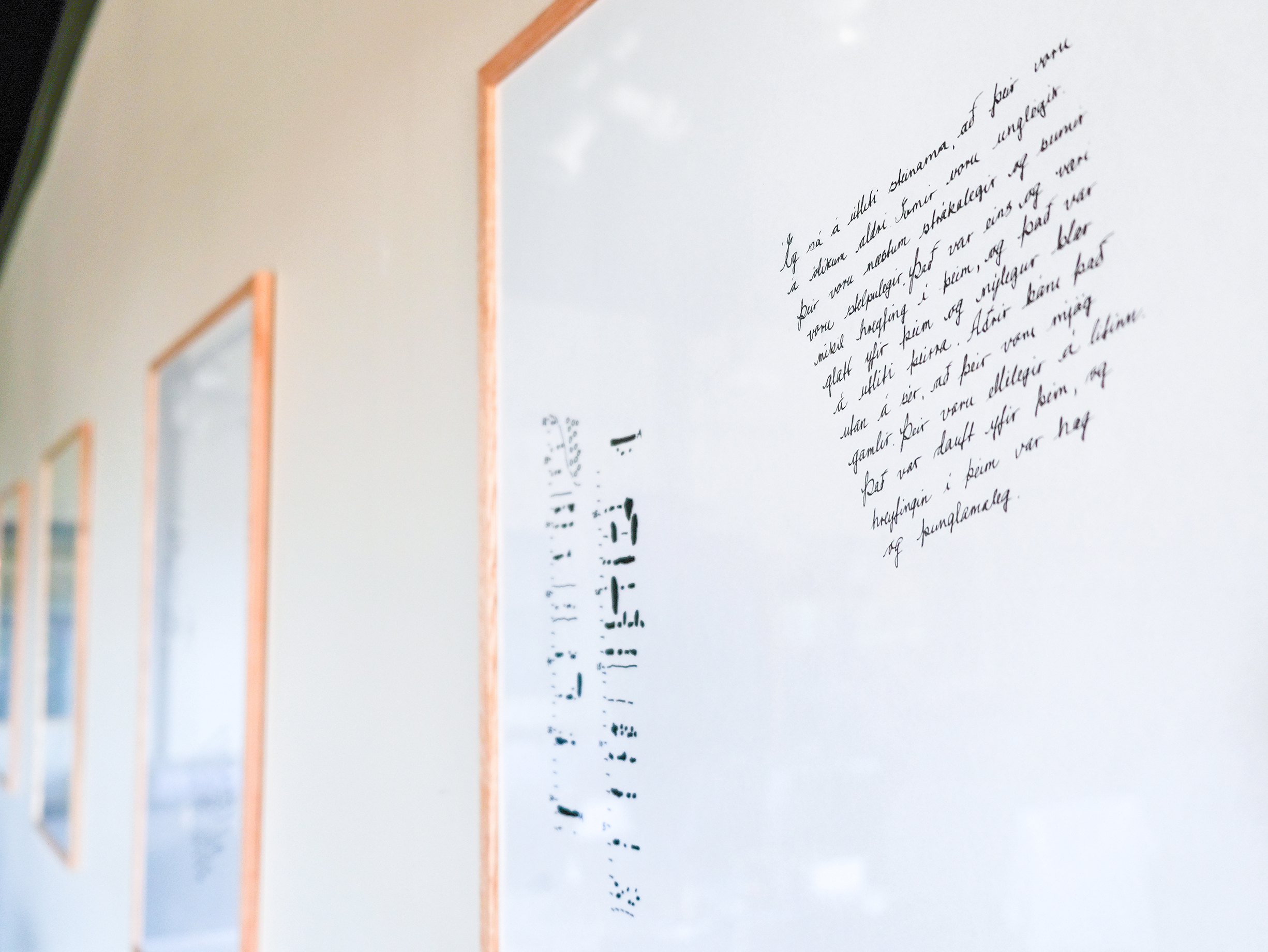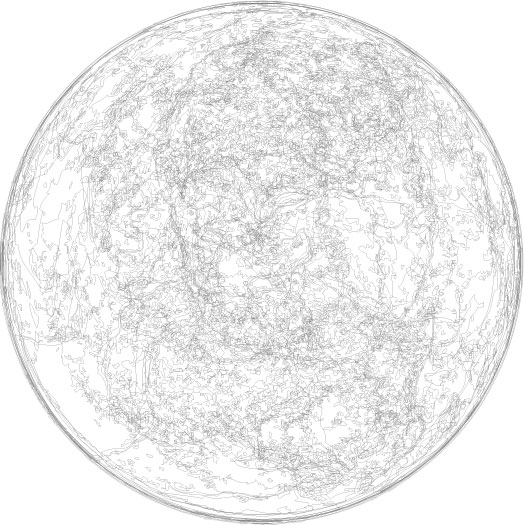
Tímasetning - blek á pappír, 50X70cm - María Sjöfn, 2024
(English below)
Þórbergssetur, Hali in Suðursveit
Tímasetning er sería verka sem ég vann í samstarfi við Þórbergssetur, Breiðdalssetur og Rannsóknasetur Háskóla Íslands á Breiðdalssvík. Þar skoða ég skrif Þórbergs Þórðarsonar um hið fjölbreytilega lífríki í Suðursveit með tengingum við rannsóknir jarðfræðingsins dr. George Walker, sem vann að og skrásetti jarðsögu Austurlands.
Verkið er hluti af myndlistarsýningu Nr. 5 Umhverfing og er ferðalag um sveitarfélagið Hornafjörð og er varðað listaverkum eftir 52 myndlistarfólk sem hefur tengingar við svæðið.
Vefsíða: https://www.academyofthesenses.is/
@academyofthesenses
#umhverfing
Sérstakar þakkir til Þórbergs Torfasonar, Maríu Helgu Guðmundsdóttur, Þórbergsseturs, Breiðdalsseturs, fjölskyldu, vina og vandamanna.
1
Þaðan þarna hefur hann komið. Þarna hefur hann átt heima í milljónir ára, að hugsa sér: að eiga heima á sama stað í milljónir ára. Og ég gæti kannski séð af nýja litnum á skellunni, hvað langt væri síðan hann flutti sig: fimmtíu, hundrað, hundrað og fimmtíu ár.
Því hefur mér aldrei dottið þetta í hug áður: Sumir steinar hafa kannski staðið á rákum og klettabrúnum eins og sjálfstæðar persónur, áður en þeir fluttu sig, og þá sjást engin ból eftir þá í klettabeltum.
2
Þarna stóð hann í grjótskriðu uppi í Mosunum eins og ljósbleik hulduvera, ólíkur öllum öðrum steinum, einn sér, algerður einstæðingur. Hann hafði engan til að tala við. Ég vorkenndi honum. Mér fannst honum hlyti að líða illa af því, hvað hann var einmana, eins mikið lifandi og hann var.
Hann var svo hlaupalegur til að sjá, að mér sýndist hann alltaf ætla að fara að taka til fótanna niður brekkuna, kannski til gráa steinsins niðri í Dýjunum, svo að hann hefði einhvern til að tala við.
3
En steinar, sem eru bundnir í klettabelti, sjá aðeins fram fyrir sig. Hann getur samt verið milljóna ára gamall, fyrst milljónir ára bandingi í klettabelti, so hundruð eða þúsundir ára sjálfstæð vera á klettarák eða bergbrún.
Kannski er það sona með steininn í skriðunni. Það gæti alveg eins verið. Ég hef aldrei getað fundið ból eftir hann, og þó er ég áreiðanlega búinn að glápa eftir því hundrað sinnum. Og þá veit hann ennþá meira en ég hélt, því að steinar, sem standa út af fyrir sig, geta séð það, sem gerist allt í kringum þá.
4
Ég fór strax að horfa upp til skriðunnar, þar sem steinninn átti að standa. Ég sé engan stein. Ég sit nokkra stund og stari. Enginn steinn. „Það hlýtur að vera af því, að sólin er ekki komin nógu langt ennþá.“ Ég vind höfðinu og horfi til sólar. „Hún er komin vestur á eystra rennuhúsið á Breiðabólsstað. Ekki alveg komið hádegi enn.“ Ég sný höfðinu aftur í norður og held áfram að stara upp í skriðuna og passa mig að hvika augunum aldrei af henni, svo að ég missi ekki af, þegar að steinninn byrjar að sjást.
Á svipstundu stóð hann alskapaður í skriðunni eins og björt andavera, sem birtist manni fram úr myrkri, áður en maður veit af…
5
Eiginlega hafði enginn tekið eftir því, sem var dularfullt við þennan stein nema ég. Og auðvitað hafði enginn hugmynd um, hvenær hann hefði flutt sig búferlum ofan úr klettunum.
Ef ég gæti fundið skellu í einhverju klettabelti nokkurnveginn upp af honum, álíka stóra og hann, svipaða í laginu og hann, eins á litinn og hann, dálítið hjáleita klettabeltinu í kringum hana, solítið nýlegri en það…
6
Gaman væri að vita, hvenær þessi steinn hefur komið, hvaða ár, í hvaða mánuði og hvaða mánaðardag, hvaða dag í viku, hvort heldur á degi eða nóttu, yfir hvaða kennileiti sólina bar þá eða sjöstjörnuna, hvaðan úr klettunum hann kom, hvort heyrðust miklir skruðningar, þegar hann var að koma, hvort sást mikill reykur eftir hann uppi í klettunum, þegar hann var að hoppa niður, hvort sáust djúp för eftir hann í brekkunum, hvernig veðrið var…
7
Ég sá á útliti steinanna, að þeir voru á ólíkum aldri. Sumir voru unglegir. Þeir voru næstum strákalegir og sumir stelpulegir. Það var eins og væri mikil hreyfing í þeim, og það var glatt yfir þeim og nýlegur blær á útliti þeirra.
Aðrir báru það utan á sér, að þeir voru mjög gamlir. Þeir voru ellilegir á litinn. Það var dauft yfir þeim, og hreyfingin í þeim var hæg og þunglamaleg.
Í brekkunum fyrir ofan Breiðabólsstaðarbæina voru nokkrir stórir steinar. Þeir voru ekki mjög stórir, og sumir voru minni en aðrir. Þeir stóðu þar á víð og dreif.
Bio
María Sjöfn vinnur í mismunandi miðla og oft með náttúruleg fyrirbæri og skoðar samband manns og umhverfis sem taka á sig mynd sem innsetningar, í þrívíð form sem skúlptúrar, video-innsetningar og teikningu.
Í verkum sínum fjallar hún um fjölþætta skynjun umhverfisins með innsýn í innra og ytra samhengi rýmis og efnis. Hún er að kanna snertifleti manns og náttúru á gagnrýninn hátt í marglaga þekkingarsköpun og skoðar myndmálið sem á stundum veitir ný sjónarhorn.
Hún lauk M.A. gráðu frá Myndlistardeild Listaháskóla Íslands árið 2020 og M.A. diplóma gráðu í listkennslufræðum árið 2014 frá sama skóla.
vefsíða: http://mariasjofn.net
@mariasjofn
![]()
Timing - ink on paper, 50x70cm - María Sjöfn, 2024
Timing is a series of works that I made in collaboration with Þórbergsetur and the Research Center of the University of Iceland in Breiðdalsvík. There I look at Þórbergur Þórðarson's writings about the diverse biosphere in Suðursveit with connections to the research of the geologist dr. George Walker, who worked on and documented the geological history of the East.
The work is a part of an art exhibition No. 5 Around and is a journey through the municipality of Hornafjörður and is a path of artworks by 52 visual artists who have connections to the area.
https://www.academyofthesenses.is/
@academyofthesenses
#umhverfing
1
There, that's where it came from. That's where it had had its home for millions of years. Just think, to have a home in the same place for millions of years. And I could maybe see from the new colour of the dent how long it had been since it moved: fifty, a hundred, hundred and fifty years. If it'd been longer, the dent would probably have attained the same colour as the rock face around it,
Why've I never thought of this before: maybe some rocks have stood on ledges and crag rims as completely individual characters before they transported themselves, and so then there wouldn't be any mark left by them in the crag belts.
2
There it stood in a stony scree up in Mosar, like a pale pink hidden being, unlike all other rocks, one of a kind, a unique individual. It had no one to talk to and I pitied it. I felt it must feel very sad because it was so lonely, it looked so alive.
It looked so like a runner that it seemed it was always just about to take to its heels down the slope, maybe to the grey stone in the Dy fields, so it would have someone to talk to.
3
But rocks which are fixed in crag belts can only see straight ahead. It can still be a million years old, the first millions of years being captive in a rock face before enjoying hundreds or thousands of years' independence on a ledge of a crag or cliff edge.
Maybe the rock in the scree is like that. It could very well be so. I've never been able to find an imprint of its home, and I've been gawping for it hundreds of times for sure. And that means it knows more than I thought, we rocks which stand out on their own can see everything that happens all around them.
4
I immediately started looking up into the scree at Mosar where the rock should be. I see no rock. I sit for a while and stare. No rock. 'It must be because the sun hasn't come far enough yet.' I twist my head round and look towards the sun. 'It's now moved further west to be over the eastern runnelled house at Breiðabólsstaður. Not yet quite midday. I turn my head back northwards and keep staring up into the scree, taking care never to take my eyes off it so that I won't miss the moment when the rock begins to be visible.
In a single moment it stood there completely created in the scree like a bright spiritual being which appears to you from out of the dark before you're even aware of it.
5
Actually, no one had noticed how mysterious this stone was except me. And of course no one had the least idea when it had moved its home from the crags above.
I often tried hard to work out visually from which belt of crags it had come, and I was trying to think thus: If I could find a dent in one of the crag belts somewhere roughly above it, as big as the rock itself, with a similar shape and the same colour, with a slightly different hue from the crags around it, just a wee bit newer than it.
6
It'd be really nice to know when this rock had arrived, what year, what month and day of the month, what day of the week, whether during the day or at night, over which landmark was the sun or the Pleiades located then, from where in the crags did it come, if any great rumbling was heard when it was com-ing, whether there was much of a dust cloud to be seen in the crags when it came bouncing down, whether it made deep marks in the slopes, what was the weather like.
7
I saw from the appearance of the rocks that they were of differing ages. Some were young-looking. They were almost boyish, and some girlish, it was as some eirlish, it was as though they were lively and happy in their movements and with freshness in their looks.
Others bore the signs of being ancient and were aged in colour. There was something dull about them and their movements were slow and cumbersome.
On the slopes above the Breiðabólstaður farmsteads were some large stones and rocks. They weren't very big and some were smaller than others. They were scattered around here and there.
Bio
María Sjöfn’s artistic practice explores forms of natural phenomena and the nature of relationships between human and non human life. Her works often take the shape of installations, sculptural interventions, video, and drawing.
Her working process begins with experimentation focusing on multifaceted perceptions of the environment, and in particular the inner and outer contexts of space and matter. She critically investigates the layered relations of the human being with its environment. When those layers are examined in a new context, visual language can create a new perspective on the matter.
María Sjöfn holds a M.A. in Fine Art from the Iceland University of the Arts (2020) and an M.A.dipl. in Art Education (2014) from Iceland University of the Arts.
website: http://mariasjofn.net
@mariasjofn



